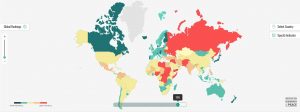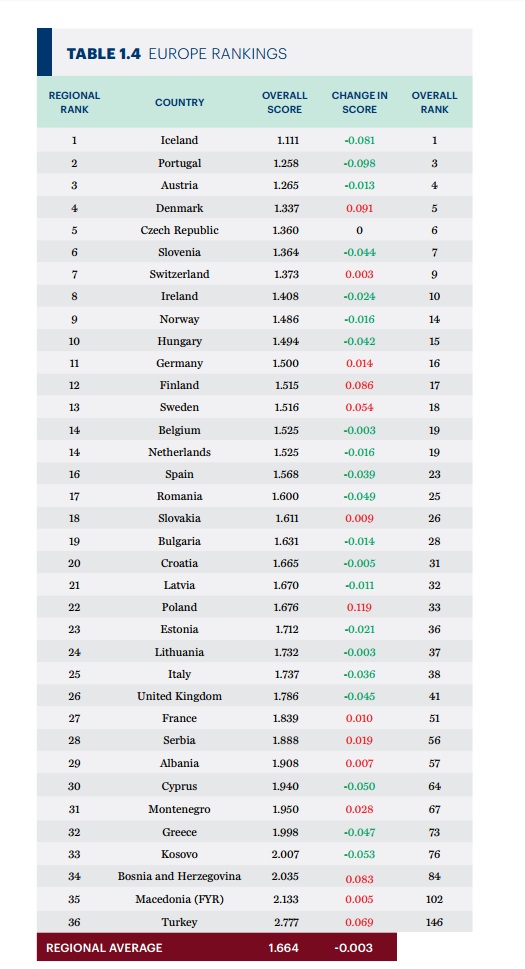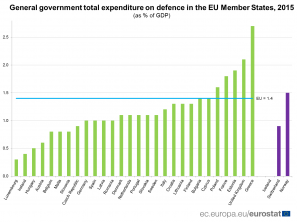From Iceland to Syria. The map of the most and the least peaceful countries in the world
Since 2008, when the first Global Peace Index was released, Iceland remained the most peaceful country in the world every year, while Syria is the world’s least peaceful country for the second successive year. The country has fallen 64 places in the rankings since the first index and has had the largest fall regarding the score of any country in the last decade.
The eleventh edition of the Global Peace Index (GPI), the world’s leading measure of global peacefulness, which ranks 163 independent states and territories according to their level of peacefulness, produced by the Institute for Economics and Peace (IEP), reveals that Iceland is the most peaceful country in the world for the eleventh year in a row.
“Iceland has maintained its position as the most peaceful country in the world in the 2017 GPI and has been ranked as the world’s most peaceful country every year since 2008. It was also ranked as the most peaceful country on two of the three domains covered in the GPI, Societal Safety and Security and Militarisation,” the report reads.

Iceland is followed at the top of the index by New Zealand, Portugal, Austria, and Denmark, all of which were ranked highly in last year’s GPI.
“Iceland remains at the top of the global ranking, followed by Portugal, which has made the biggest improvement in the region. The continuation of the economic recovery has supported an improvement in the score for indicators such as the likelihood of violent demonstrations. The largest drop in score is recorded by Poland, driven by a deterioration in the intensity of organised internal conflict and likelihood of violent demonstrations. Several of the policies enacted by the government of the right-wing PiS party, which took power in 2015, have led to growing tensions between liberal and socially conservative values, resulting in public protests,” the report reveals.

Syria remains also in 2017 at the bottom of the index, being the least peaceful country in the world for the second year in a row, preceded by Afghanistan, Iraq, South Sudan, and Yemen.

Across the world, six of the nine regions improved. Thus, South America had the largest improvement, with particularly strong gains in the field of Societal Safety and Security, overtaking Central America and the Caribbean as the fourth most peaceful region.
“The largest regional deteriorations in score occurred in North America, followed by sub-Saharan Africa and the Middle East and North Africa (MENA). The score for North America deteriorated entirely as a result of the US, which more than offset a mild improvement in Canada. The US’s score has been dragged down largely because of a deterioration in two indicators: level of perceived criminality in society and the intensity of organised internal conflict. The latter measure has deteriorated because of the increased levels of political polarisation within the US political system. The US also has experienced the fourth largest drop in Positive Peace globally, after Syria, Greece and Hungary in the ten years to 2015,” the report reads.
The report also shows that while the Central African Republic had the strongest improvement in score in the 2017 GPI, rising two places in the rankings to 155, Ethiopia had the largest deterioration in peacefulness, falling 16 positions in the rankings to 134.

Despite the latest terrorist attacks, Europe is still the most peaceful region in the world
Much of south-east Europe saw its score decrease in 2017, due to an increase in nationalist rhetoric, which led to a deterioration in relations with neighbouring countries for Bosnia and Herzegovina and Croatia, while Montenegro (67th) saw a strong growth in political instability following a tumultuous election in October 2016 that involved an alleged attempted coup. Despite these negative changes, Europe remains the most peaceful region in the world, with eight of the ten most peaceful countries coming from this region.
“While 23 of the 36 countries improved, the average peace score did not change notably, due to the substantial deterioration in Turkey, the impact of the terrorist attacks in Brussels, Nice, and Paris, and deteriorating relations between Russia and its Nordic neighbours,” the report reads.
With regards to Western Europe, France fell another five places to 51st in the global ranking, the deterioration being largely influenced by an increase in the impact of terrorism after the attack in Nice in July 2016, the latest in a number of terrorist attacks in recent years.
Also, the report states that other Western European countries have seen their scores decreasing due to terrorist attacks, including Germany and most of the Nordic countries.

“Although the risk of conflict remains low, tensions between Russia and the Nordic countries increased further in 2016, leading to the scores for relations with neighbouring countries of Denmark, Finland, Norway and Sweden also deteriorating, substantially impacting their scores”.
Regarding the Brexit vote in the UK, although the result revealed high levels of polarisation within the society, which led to political uncertainty, the political scene was relatively stable after the new prime minister Theresa May was installed.
“A continued improvement in the UK’s overall score was driven by international conflict indicators, following the country’s withdrawal from Afghanistan in 2014,” the report reads.
On the other hand, Turkey remains the most significant outlier in Europe, falling in 2017 another place in the global ranking, to 146th, as its scores for the number of deaths from internal conflict, political terror scale and the impact of terrorism deteriorated significantly.
“The political situation had been worsening in Turkey over the last few years but the situation came to a head in July 2016, when parts of the military attempted a coup, resulting in a government crackdown on alleged conspirators.
World’s least peaceful region
At the other end of the scale, MENA is the least peaceful region in the world for the fifth successive year. Saudi Arabia, followed by Libya, recorded the largest deteriorations from this region.
“Saudi Arabia fell because of its involvement in the Syrian and Yemen conflicts and increased terrorist activity, mainly conducted by ISIL and its affiliates, while the fall for Libya was due to its increased level of internal conflict,” the report also reads.
While the peace index slightly improved in 2016, the world was less peaceful over the past decade
Although the results of the 2017 GPI find that the global level of peace have slightly improved this year by 0.28 per cent, with 93 countries improving and 68 countries’ situation deteriorated, since 2008, the global level of peace has deteriorated by 2.14 per cent, a trend which has been driven by conflict in the Middle East, global terrorism, and population displacement.
Moreover, according to the report, in the analysed period, the inequality in peace between the most and least peaceful countries grew. Thus, the GPI shows that the difference in score between the least peaceful and most peaceful countries has been increasing.
“The ten-year trend in peacefulness finds that global peacefulness has deteriorated by 2.14 per cent since 2008, with 52 per cent of GPI countries recording a deterioration, while 48 per cent improved. The global level of peacefulness deteriorated rapidly after the global financial crisis, however, since 2010, the movements have been within a small range, resulting in this year’s levels of peacefulness returning to approximately the same level as in 2010”.
Over the ten-year period, the domain that deteriorated the most was the safety and security area, with 61 per cent of countries recording a deterioration. “The major falls in this domain occurred in the sub-Saharan Africa region due to increases in terrorism impact and political instability”.
Instead, the domain with the largest improvement was militarisation, since 60 per cent of countries became less militarised over the past decade.
“It is important to note the global trend in peacefulness has been dominated by developments in the MENA region. The violence and conflict has been so intense that if the region were excluded from the rest of the world, the average levels of peacefulness would not have changed significantly over the last decade,” the report reads.
According to the same source, the terrorism impact indicator had the largest deterioration with 60 per cent of countries having higher levels of terrorism than a decade ago, which reflects the historically high numbers of people killed in terrorist incidents over the past five years.
“The heightened media attention on the conflict in the Middle East, refugee flows and terrorism in Europe has meant several positive trends have not been as widely covered. Two of the more positive trends from the last decade are decreases in the homicide rate for 67 per cent of the countries covered and improvements in the political terror dcale which measures state-sponsored violence, such as extra-judicial killings and torture, where 68 countries improved, compared to 46 that deteriorated,” shows the report issued by the Institute for Economics and Peace (IEP).
The price of global violence
Last year, the total economic impact of violence was $14.3 trillion, equivalent to 12.6 per cent of gross world product, or $1,953 per person.
“The economic impact of violence on the global economy in 2016 was $14.3 trillion in purchasing power parity (PPP) terms. This figure is equivalent to 12.6 per cent of the world’s economic activity (gross world product), or $1,953 for every person, and is three per cent lower than in 2015. The reduction was mainly due to decreases in the number of people killed by terrorism, which dropped ten per cent, as well as lower expenditure on peacekeeping, lower internal security and lower costs from homicide,” the report points out.
IEP’s report presents the most comprehensive data-driven analysis to-date on trends in peace, its economic value, and how to develop peaceful societies.
How much is spent on defence
Between developed and developing countries, there is a diverging trend, according to IEP’s report. Thus, in constant 2014 USD, the average military expenditure for developed countries decreased by 25 per cent from 1987 to 2015, while developing countries, such as Egypt, India, Iran, Pakistan, South Korea, and Syria, have increased the spending for heavy weapons capabilities by an average of 240 per cent.
The latest report issued by Eurostat, the statistical office of the European Union, shows that in 2015, the EU’s 28 Member States earmarked €200 billion of public expenditure for ‘defence’. The amount is equivalent to 1.4% of GDP.
“This is much less than the amount spent on social protection (expenditure equivalent to 19.2% of GDP in 2015), health (7.2%) or education (4.9%), but significantly higher than public spending on recreation, culture and religion (1.0%), environmental protection (0.8%) and housing and community amenities (0.6%),” Eurostat’s report reads.
The ratio of government defence expenditure to GDP varied across EU Member States from 0.3% in Luxembourg, 0.4% in Ireland, 0.5% in Hungary and 0.6% in Austria, to 2.7% in Greece, 2.1% in the United Kingdom, 1.9% in Estonia and 1.8% in France.

In absolute terms, in 2015, the United Kingdom spent by far the most on defence (€55 bn in 2015). This is equivalent to over a quarter (27%) of the total EU public expenditure on defence. France followed it with a total of €38 bn, or 19% of the EU total, then Germany (€30 bn, or 15%) and Italy (€20 bn, or 10%). These four Member States accounted together almost three-quarters of the total defence expenditure in the EU, respectively 72%.